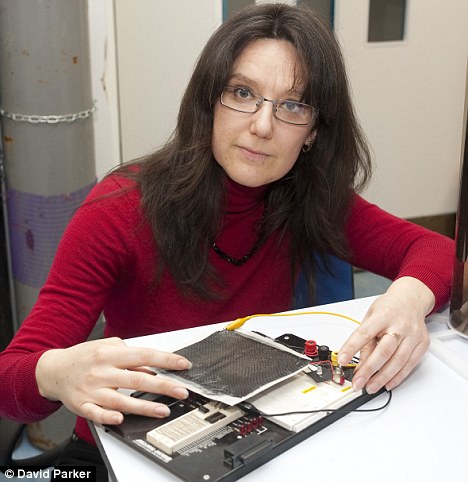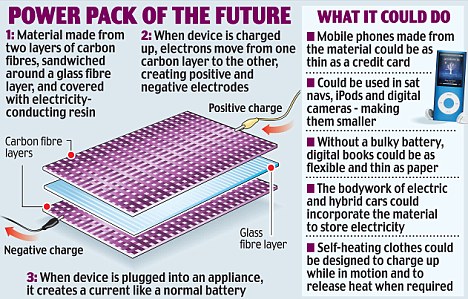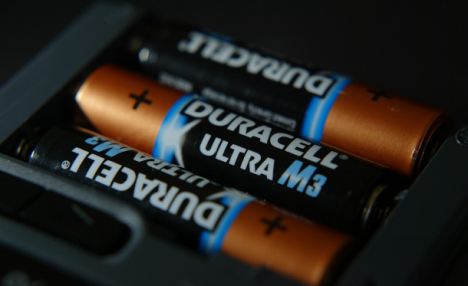The Infidel World May Have Come Up With A Solution To The Threat Of An EMP Attack
The battery's dead: Scientists invent wafer-thin plastic that can store electricity
The battery, which has powered our lives for generations, may soon be consigned to the dustbin of history.
British scientists say they have created a plastic that can store and release electricity, revolutionising the way we use phones, drive cars - and even wear clothes.
It means the cases of mobiles and iPods could soon double up as their power source - leading to gadgets as thin as credit cards.

Researcher Natasha Shirshova with her team's invention

The technology could also lead to flexible computer screens that can be folded up and carried around like a piece of paper.
And it could even be used to create 'electric clothes' that charge up as a person moves around and which slowly release heat when the weather gets cold.
Dr Emile Greenhalgh, from Imperial College London's Department of Aeronautics, said the material is not really a battery, but a supercapacitor - similar to those found in typical electrical circuits.
His team's prototype - which is around five inches square and wafer-thin - takes five seconds to charge from a normal power supply and can light an LED for 20 minutes.
Dr Greenhalgh, who is working with car company Volvo on a three-year, £3million project to use the material in hybrid petrol-electric cars, said: 'We think the car of the future could be drawing power from its roof or even the door, thanks to our material.
'The applications for this material don't stop there - you might have a mobile that is as thin as a credit card because it no longer needs a bulky battery, or a laptop that can draw energy from its casing so it can run for longer.'
The material charges and discharges electricity quicker than a conventional battery, and does not use chemical processes - giving it a longer lifespan, he added.
The scientists plan to use it to replace the metal floor of a Volvo car's boot which holds the spare wheel.
This would mean Volvo could shrink the size of its hybrid battery - and cut down the weight of the car, making it more efficient.
Dr Greenhalgh said: 'No one has created a material like this - within ten years it could replace batteries.'

The new patented material from scientists at Imperial College could do away with the need for traditional batteries forever
But, my thinking here is, if this plastic can store and release electricity, then it would seem it could eventually be used to conduct electricity. Perhaps it's conductivity powers would be slower.
From what I'm reading here in this article, movement may have to be added to the equation. The article says, the movement of a human body could charge the "supercapacitor". If it can charge through movement, then does not movement actually cause it to conduct electricity as well?
Perhaps extremely fast quivering of very thin strings of such a plastic could speed up it's conductive capacity.
Of course, I'm talking out of school here. So, I'm sure some of our readers can tell me if I am off base in my assumptions.
- Off Grid Hybrid Solar Wind Power System For Home Use
Wind turbine and solar panel generate electricity, the electricity is charged into the battery group by the charging controller, and then through inverter, the system supply AC power for loads. When there is no electricity in batter group, inverter will...
- Rechargeable Battery
A rechargeable battery is one kind of electrical battery which contains one or more electrochemical cells. It's electrochemical reactions are electrically reversible. That's why it is familiar as secondary cell. Rechargeable batteries are of different...
- How Do I Calculate The Solar Pv Requirement For My House?
The reduced cost of solar photo-voltaic panel has created interest in households to opt for a solar panel on their roof top we have been getting various inquiries for roof top system sizing. Typically a house requires an average load of 2KW and 8 hours...
- Could We Finally Power Cars With Solar Panels?
Article originally published on dailymail in July 20th 2015. Nanowire technology may allow new types of hydrogen fuel cell for vehiclesScientists created a grid of tiny wires of gallium phosphide to split waterThis harnessed the sun's energy...
- Making 'renewable' Viable: New Technology For Grid-level Electrical Energy Storage Developed
Article published on http://www.sciencedaily.com, June 11th 2012 In the aftermath of the recent United Nations Rio+20 Conference on Sustainable Development, the focus of many industrialized nations is beginning to shift toward planning for a sustainable...
